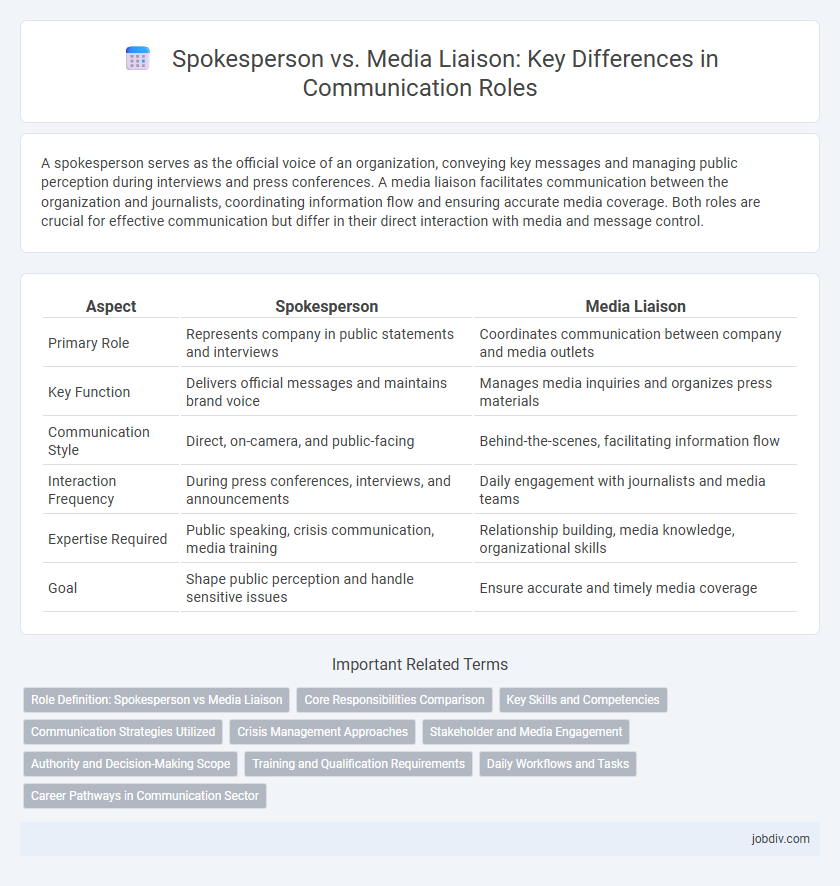A spokesperson serves as the official voice of an organization, conveying key messages and managing public perception during interviews and press conferences. A media liaison facilitates communication between the organization and journalists, coordinating information flow and ensuring accurate media coverage. Both roles are crucial for effective communication but differ in their direct interaction with media and message control.
Table of Comparison
| Aspect | Spokesperson | Media Liaison |
|---|---|---|
| Primary Role | Represents company in public statements and interviews | Coordinates communication between company and media outlets |
| Key Function | Delivers official messages and maintains brand voice | Manages media inquiries and organizes press materials |
| Communication Style | Direct, on-camera, and public-facing | Behind-the-scenes, facilitating information flow |
| Interaction Frequency | During press conferences, interviews, and announcements | Daily engagement with journalists and media teams |
| Expertise Required | Public speaking, crisis communication, media training | Relationship building, media knowledge, organizational skills |
| Goal | Shape public perception and handle sensitive issues | Ensure accurate and timely media coverage |
Role Definition: Spokesperson vs Media Liaison
A spokesperson serves as the official voice of an organization, delivering key messages directly to the public and handling high-profile communications. A media liaison, on the other hand, acts as the intermediary between the organization and journalists, facilitating information flow and managing media inquiries. Both roles are critical in maintaining clear and consistent communication, but the spokesperson is more public-facing while the media liaison focuses on relationship-building and coordination.
Core Responsibilities Comparison
A spokesperson serves as the official voice of an organization, delivering key messages and representing the company during press conferences and public engagements. In contrast, a media liaison focuses on managing relationships with journalists, coordinating press releases, and facilitating communication between the organization and media outlets. Both roles are essential for effective communication, with the spokesperson emphasizing message delivery and the media liaison prioritizing media coordination.
Key Skills and Competencies
A spokesperson excels in public speaking, message clarity, and media interview management, ensuring consistent brand representation. A media liaison specializes in relationship-building, media monitoring, and strategic communication coordination between an organization and journalists. Both roles demand strong interpersonal skills, crisis communication ability, and media knowledge but differ in execution focus--spokesperson on public-facing interaction, media liaison on behind-the-scenes media engagement.
Communication Strategies Utilized
A spokesperson delivers key messages directly to the public and media, embodying the organization's voice and maintaining consistency in communication strategies through clear, persuasive storytelling. A media liaison facilitates interactions between the organization and journalists, focusing on relationship-building, timely information dissemination, and managing media inquiries to ensure accurate and favorable coverage. Both roles utilize tailored communication approaches, with the spokesperson emphasizing message control and the media liaison prioritizing information flow and media engagement.
Crisis Management Approaches
A spokesperson serves as the official voice of an organization, delivering clear, authoritative messages during a crisis, while a media liaison facilitates information flow between the organization and journalists, ensuring accurate and timely updates. Crisis management requires the spokesperson to maintain consistent messaging to build trust, whereas the media liaison manages relationships to prevent misinformation and control the narrative. Effective crisis communication leverages both roles to balance transparency and reputation protection, minimizing public confusion and organizational damage.
Stakeholder and Media Engagement
A spokesperson directly represents an organization, delivering official messages and responding to stakeholders and media inquiries with authoritative statements. A media liaison facilitates communication pathways between the organization and media professionals, ensuring accurate information flow and managing relationships to enhance media engagement. Both roles are essential for maintaining transparent, effective communication strategies that build trust and influence public perception among key stakeholders.
Authority and Decision-Making Scope
A spokesperson holds authoritative power to represent and make official statements for an organization, often possessing decision-making capabilities on messaging and crisis communication. A media liaison primarily facilitates information flow between the organization and the media, operating under guidance without autonomous authority to alter core messages. The spokesperson's role requires higher strategic involvement and accountability, while the media liaison focuses on execution and relationship management.
Training and Qualification Requirements
Spokespersons require advanced communication skills, media training, and often hold degrees in public relations, journalism, or communications to effectively represent an organization's voice. Media liaisons typically focus on relationship management and coordination, requiring specialized training in media protocols, crisis communication, and organizational policies. Both roles demand ongoing professional development to stay updated on media trends, legal considerations, and technology tools essential for effective information dissemination.
Daily Workflows and Tasks
A spokesperson primarily delivers official statements and represents the organization in media interactions, focusing on crafting key messages and responding to public inquiries. A media liaison facilitates communication between the organization and journalists, coordinating interviews, distributing press materials, and managing media lists. Daily workflows for spokespeople center on message preparation and public speaking, while media liaisons handle outreach, logistics, and maintaining media relationships.
Career Pathways in Communication Sector
A spokesperson typically acts as the official voice of an organization, delivering key messages and managing public relations during high-stakes situations, while a media liaison specializes in building and maintaining relationships with journalists to facilitate smooth information exchange. Career pathways for a spokesperson often evolve from roles in public relations, corporate communication, or crisis management, emphasizing strong verbal and presentation skills. Media liaison roles usually begin with experience in media relations or journalism, focusing on networking, press release crafting, and strategic communication to support organizational visibility.
Spokesperson vs Media Liaison Infographic

 jobdiv.com
jobdiv.com